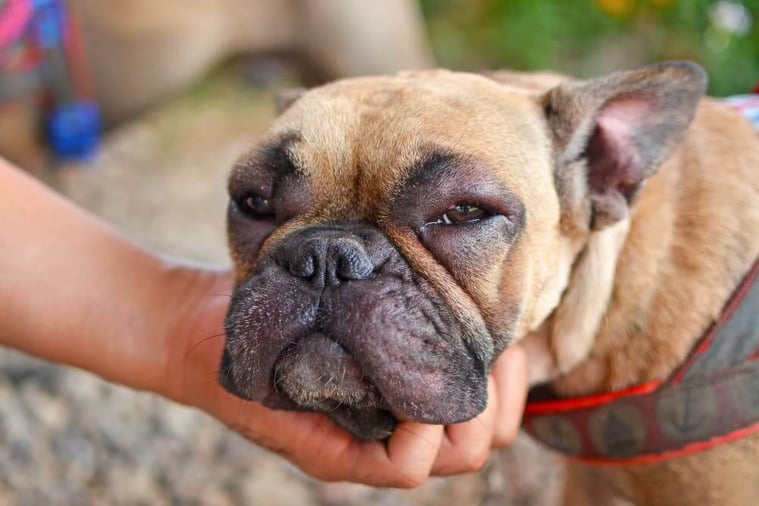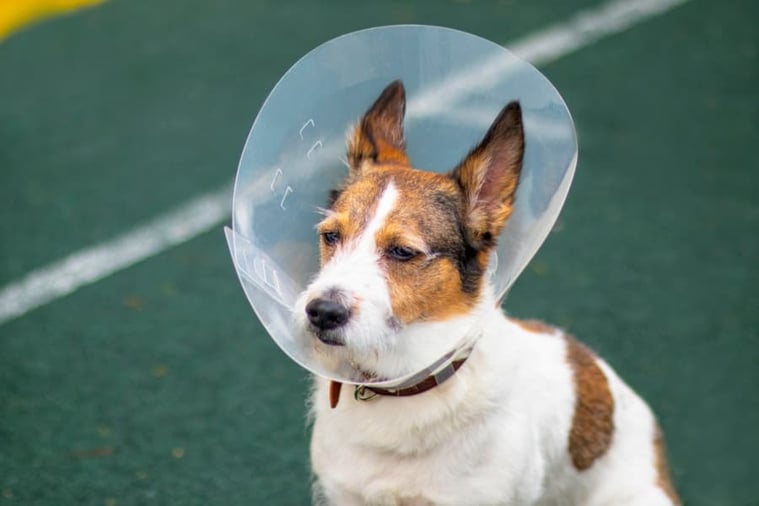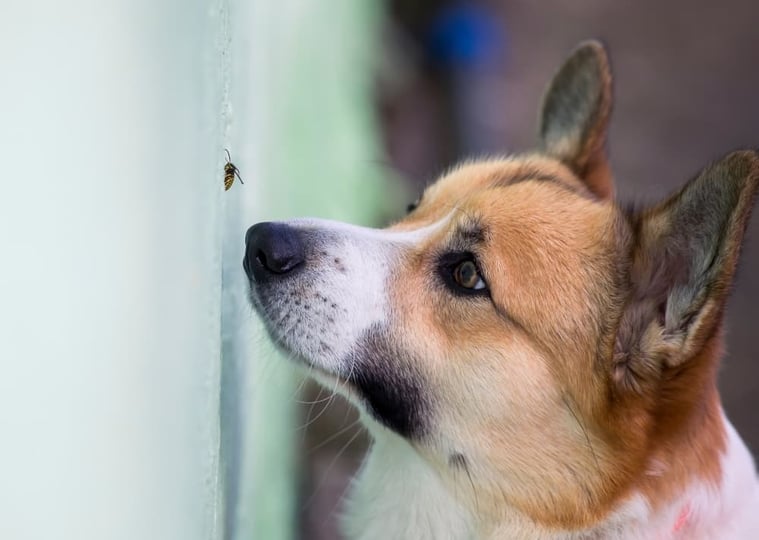
As the weather warms up, lots of flying pests start to buzz around your dog. Some insects are just annoying, while others, like bees, can be dangerous to a curious pooch. Find out what to do about bee stings on dogs. Multiple stings can easily prove extremely dangerous or even life threatening.
My dog got stung by a bee in the face? What do I do? Don't panic!
The reaction from a single bee sting could be as mild as an itchy bump to a full-blown anaphylactic incident. As a pet parent, you need to always be prepared for a possible insect sting on your dog.
When a dog is stung by a bee, the reactions are typically more on the mild side, but several bee stings on dogs in the wrong spot can lead to some uncomfortable, painful, and even life-threatening symptoms such as a rapid heart rate and difficulty breathing.
How to Recognize a Bee Sting on Dogs
You won't always see your dog get stung by a bee, but you can recognize the symptoms of a bee sting. Most dogs will yelp or cry when a dog bee sting occurs.
Dogs stung on the paw may start to limp or lick its paw. Most bee stings are not serious, but you should still keep a close eye on the area.
Reactions in a dog typically occur within a few minutes of the sting, but you may not notice the sting itself as much as your dog's reaction to the bee sting.
Knowing what to look out for if your dog is stung can help you act quickly and treat the symptoms of the bee sting to ease your dog's discomfort.
Symptoms of a Dog Bee Sting
Did your dog get stung by a bee? A dog's bee sting will exhibit the following reactions:
-
- Redness
- Swelling
- Itchiness
- Hives
- Pain
- Rapid heart rate
- Difficulty breathing
- Whining or yelping
While a bee sting on your dog's body and legs will often be a mild inconvenience and easily treated, bee stings on more delicate parts of the body may have stronger reactions.
The dog's face, in particular, can lead to greater swelling and more painful reactions, especially if it experiences multiple stings, which will produce a severe reaction.
Bee stings on the eyelids and nose can be the most painful for your dog, and the swelling can affect sight and breathing if the bee sting isn't treated quickly. It is imperative that a pet parent react promptly to the emergency and seek a veterinarian immediately.
Your pet may require medication to alleviate the reaction at the emergency vet to halt the anaphylactic reaction. You'll need to know your dog's body weight to determine the proper dosage.
Bee Sting on Dog Paw
Sometimes your dog may get surprised by a bee sting to the paw. This happens when they are walking through gardens, fields, and any other grassy areas that may have short flowers to pollinate.
Your dog could accidentally step on a bee and get a quick and painful jab in the paw. While you are likely to see minimal swelling, a sting on or in between the pads of your dog’s paw can be quite painful.
Limping and lifting their paw will be the first sign that there is something wrong, so if you notice this odd behaviour, do a quick inspection of the paw to identify a possible bee sting or bug bite.
Protecting your dog's paws from bees, bugs, and even the elements is easy with a good pair of all-season dog boots.
My Dog Ate a Bee!
So, your curious pooch ate a bee. Ouch! That's gonna sting... literally!
A sting to the mouth or tongue is one of the more common bee stings in dogs because dogs explore with their mouths, so trying to eat the bee, or at least taste it, often leads to a bee sting.
A sting on the tongue can also be worrisome if the tongue starts to swell. It can lead to difficulty breathing and eating, so it’s important to act quickly to keep your dog safe. Minimal swelling will go down on its own or after an ice pack application, but more severe reactions may mean a trip to the vet.
The good news is, the bee itself isn’t toxic, so if your dog manages to actually eat one, it won’t make him sick, but it is unlikely he’ll get the bee down without getting stung.
Signs of Allergic Reactions in Bee Sting in Dogs?

Just like people, dogs can be sensitive to bee stings. While a regular dog's bee sting reaction is often mild, an allergic reaction to a bee sting can be much more severe. Swelling and hives are likely to present almost immediately after the sting.
This can be very dangerous if you don't act quickly. If you see the following signs such as trouble breathing or an allergic reaction from a bee sting, you need to call your vet immediately.
-
- Swelling
- Hyperventilation
- Agitation
- Laboured Breathing
- Lethargy or Collapse
- Loss of Appetite
- Vomiting
- Disorientation
Other symptoms can occur, so watch your dog closely. You might need to give your pup veterinary medicine to ease the reaction. Time and care will help your dog feel better.
Signs of an Anaphylactic Reaction
Anaphylactic reactions can quickly become serious. The life-threatening allergic reaction warrants a trip to the emergency vet. Remember, symptoms progress rapidly, especially if your dog has sustained a wasp sting multiple times.
A dog stung by multiple bees can quickly prove dangerous. The common symptoms become compounded, which puts your dog's life in danger without veterinary care.
Common symptoms of anaphylactic bee reactions include severe symptoms such as:
-
- Difficulty breathing or wheezing
- Significant swelling of the face, lips, tongue, or throat (or a more severe reaction)
- Hives or generalized itching on the dog's skin
- Rapid or weak pulse
- Dizziness or lightheadedness
- Gastrointestinal tract upset, such as nausea, vomiting, or abdominal cramps
- Confusion or disorientation
- Dip in blood pressure
- Loss of consciousness or fainting
- Chest tightness or chest pain
- Rapid onset of anxiety or feeling of impending doom
In some situations, severe facial swelling can hinder breathing which may lead to suffocation. You'll want to visit the emergency vet immediately at the veterinary clinic.
Seek a Veterinarian Immediately
It's important to note that anaphylactic reactions can occur within minutes of a bee sting, and in severe cases, they can progress rapidly.
If you suspect anaphylaxis due to a bee sting, it's crucial to seek immediate medical attention and call emergency services (911 in the United States) for assistance.
Administering epinephrine, if prescribed, and receiving prompt medical care are vital to managing anaphylactic reactions effectively. Some dogs may require oxygen therapy or various treatments for the other symptoms.
Consider an EpiPen for Insect Stings
Pet owners who know that their dog suffers extreme allergic reactions to insect bites or bee stings should ask their veterinarian for an EpiPen to treat their dog quickly for anaphylactic shock in an emergency if they cannot make it to the clinic in a timely manner.
An EpiPen is a great way to maintain your pet's health and prevent life-threatening anaphylactic shock. You will have to give your dog an injection using the EpiPen in the event of an emergency, such as a bee sting, if they are severely allergic.
An emergency vet may also administer the injection to treat the anaphylactic shock promptly.
What to Do if Your Dog Gets Stung by a Bee

Bees are generally peaceful if unprovoked by either a human or an animal. Even though we may perceive them as threats, most people would leave them be, but the same can't be said for our overprotective pets.
It's not uncommon for a dog's bark to enrage a few, but our pets sometimes try to bite them out of curiosity, if nothing else. Regardless of the cause, now your dog's face is red and swollen, so you may be wondering what to do.
Today we'll explain all the steps you should take in case you get stung by a bee, so let's begin:
Search for the stinger
It is imperative that you remove the stinger. Bee stingers are venomous, and they continue to ooze toxins until they're removed from the flesh, so you'll want to search for the stinger.
Some argue that using tweezers would result in large amounts of venom being squeezed out from the sac and onto the open wound, but it's still a safer option than leaving it there.
Scrape away the stinger
A safer option is to scrape the stinger off from your pet's coat using any thin piece of plastic (credit cards would do the trick). Use the edge of the credit card and flick out the stinger.
Never pinch the stinger, or you can force more venom into the bite wound. When you remove the stinger this way, the stinger will secrete its venom on the coat, and you will be able to direct the trajectory.
Cool the swollen area
Apply a cold compress to minimize swelling from the sting of the stinging insects. The area may show signs of swelling up to a few hours after the flying insect's sting.
The affected area will show mild irritation and itching. Use ice, a bag of frozen peas, or an ice pack to cool the swollen area.
You can also apply baking soda to wasp stings. Make a baking soda paste using a bit of water to stop the pain and reduce the swelling.
Consider giving your pet a cool oatmeal bath to soothe the sting area. Oatmeal shampoo or bath products will help ease swelling and itching.
Keep your pet from scratching itself
Dogs will instinctively try to lick their wounds, in which case they'll make matters worse. If they can't reach the location to lick, they'll try scratching it instead. When the dog disturbs the site with itching, it can become an open wound.
Both scenarios should be avoided, as licking the stinger is almost the same as getting stung again, whereas scratching a wound will make it more severe.
Open wounds are prone to infections, and your dog's immune system will already be busy handling the venom from the bee's stinger, so one of the best ways to prevent this is to use an Elizabethan collar sometimes called e-collars.
Prevent infection
Regardless of how small the reaction is, infection is always a possibility, especially if your dog has had time to lick or scratch the sting site.
Proper wound and infection treatments applied to the sting site can prevent further irritation as the wound heals.
Some veterinarians will suggest having the dog wear an e-collar to prevent the pet from licking the site of the sting.
It's always a good idea to have a pet first aid kit on hand because you never know when your dog is going to have an interaction with a bee or other flying insects.
How to Prevent Bee Stings on Dogs

Though bees are typically not aggressive, when provoked, they will instinctually sting. Often the symptoms of a bee sting are mild, but it's never worth the risk.
Help keep your dog safe from bee stings with these simple tips:
-
- Keep your dog away from beehives
- Use natural bee repellents such as vinegar
- Try a dog bug spray like Citrobug
- Place booties on your dog's feet
- Avoid playing near flowers
When to Call Your Vet
Keep a close eye on the dog's bee sting for any changes. Also, watch for signs of an emergency situation. If you feel your dog's bee sting isn't healing properly, then a trip to the veterinary clinic might be a necessity.
Allergic responses to most stings and insect bites can be managed at home. Your vet may recommend over-the-counter medications, like dog Benadryl, to control the swelling at the site, but many dogs have severe reactions that require medical intervention.
Frequently Asked Questions
What should I do if my dog gets stung by a bee?
If your dog gets stung by a bee, the first step is to remove the stinger if it's still present. Use a credit card to scrape it off gently. Avoid using tweezers or squeezing the stinger, as it can release more venom.
What are the signs of an allergic reaction to a bee sting in dogs?
Signs of an allergic reaction to a bee sting in dogs may include swelling around the sting site, hives or rash on the body, difficulty breathing, excessive drooling, vomiting, diarrhea, weakness, or collapse.
Should I be concerned if my dog is stung multiple times by bees?
Multiple bee stings can be more concerning than a single sting, especially if your dog shows signs of an allergic reaction or if the stings are located in sensitive areas such as the mouth or throat.
Can I give my dog over-the-counter antihistamines for a bee sting?
It is generally not recommended to give your dog over-the-counter antihistamines without consulting a veterinarian first.
How can I prevent bee stings in dogs?
To help prevent stings in dogs, avoid areas with a high presence of bees, such as around flowering plants or beehives in an orchard.
Should I be concerned about the long-term effects when a dog is stung?
In most cases, bee stings in dogs cause temporary discomfort and localized reactions. However, severe allergic reactions can occur. If a dog has a severe reaction, then long-term problems may arise.
.
.png?width=200&height=66&name=logo%20(1).png)



